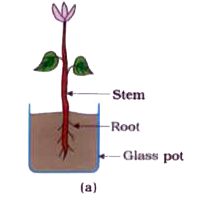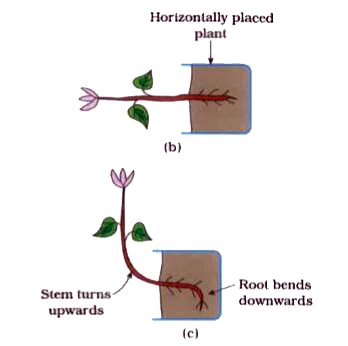Your subject teacher arranged a potted plant as shown in figure (a). Next day turn its position horizontally as shown in figure (b). After few days, you observed the plant as shown in figure (c).


State the direction of growth of root and stem in the plant.Solution in Gujrati
The growth of root is negative phototropic and positive geotropic. The growth of stem is positive phototropic.
Topper's Solved these Questions
Similar Questions
You saw a tragic road accident resulting in death of two persons. The reason for that is bike rider tried to overtake the truck from wrong-side with overspeed. He was not wearing a helmet that caused head injury.
You were scared because you also have same habit to drive activa without wearing helmet. Your father often warned you that to drive vehicle without a driving licence is a crime.
Which part of brain is involved into learning how to drive vehicle ?01:49View SolutionYou are supplied with two sets of seeds of pea plants. One set is yellow and round seeds with gene constitution YYRR and other set is green and round seeds with gene constitution yyRR. From both sets of seeds plants are cultivated. Pea plant is self-pollinated but arrange artificial cross between two given plants cultivated from seeds. Which offsprings do you expect ? show with chart.
01:38View SolutionWater stands at level A in the arrangement shown in figure. If a jet of air is gently blown into the horizontal tube in the direction shown in figure, then
02:24View Solution
Identify the plants shown in figure and select the correct option:02:52View SolutionA potted plant is kept horizontally for a considerable time. The three positions of the parts A and B of the potted plant are shown in the following figures:

(a) Which figure shows the correct position taken by the parts A and B of the plant?
(b) What type of phenomenon is exhibited by the figure chosen in (a) above?02:25View SolutionA potted plant having straight parts A and B was placed horizontally on its side as shown in Figure (i). After a few days it was observed that the parts A and B of the plant acquire new positions as shown in figure (ii).
(a) Name the phenomenon exhibited by the position of plant parts A and B in Figure (ii)
(b) Name the stimulus (other than sunlight) which causes plant part A to grow and bend upwards, and plant part B to bend downwards.
 03:22View Solution
03:22View SolutionImportance of day length in flowering of plants was first shown in
01:21View Solutionएक प्रक्रिया को निम्नलिखित चित्र में दर्शाया गया है -
(iv) इस प्लांट का एक उपयोग बताइये।
 03:20View Solution
03:20View SolutionIdentify the plants shown in figure and select the correct option:

 02:13View Solution
02:13View SolutionImportance of day length in flowering of plants was first shown in
03:52View Solution
Identify the plants shown in figure and select the correct option:View SolutionYour subject teacher arranged a potted plant as shown in figure (a). Next day turn its position horizontally as shown in figure (b). After few days, you observed the plant as shown in figure (c).


What happens when the pot along with the plant is placed as in fig. (b)?02:52View SolutionYour subject teacher arranged a potted plant as shown in figure (a). Next day turn its position horizontally as shown in figure (b). After few days, you observed the plant as shown in figure (c).


Why the growth of the entire plant as shown in fig. (b) does not occur parallel to the soil surface ?View SolutionYour subject teacher arranged a potted plant as shown in figure (a). Next day turn its position horizontally as shown in figure (b). After few days, you observed the plant as shown in figure (c).


Which type of movement does this experiment explain ?04:41View SolutionObserve the figure and answer the following questions
'(##VPU_HSS_BIO_IX_P02_C06_E01_002_Q01##)'
a. What changes do you observe in the growth of root and stem in a plant, if it is kept stationary as shown in the figure for a few days. Why? b. If the apparatus is rotated gently and continuously, what change would you, óbserve in its root and stem?01:59View Solution
